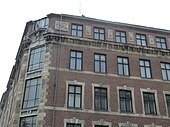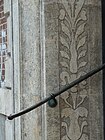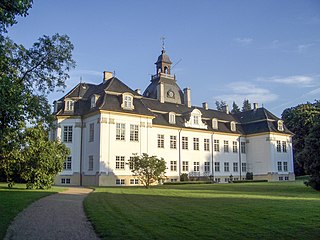
Charlottenlund Palace is a former royal summer residence in Charlottenlund, some 10 km (6 mi) north of central Copenhagen, Denmark. The palace was named after Princess Charlotte Amalie, who was responsible for the construction of the original palace. It was later extended and adapted for Crown Prince Frederick VIII to a design by Ferdinand Meldahl in the early 1880s.

Frederik's Church, popularly known as The Marble Church for its rococo architecture, is an Evangelical Lutheran church in Copenhagen, Denmark. The church forms the focal point of the Frederiksstaden district; it is located due west of Amalienborg Palace.

Østre Anlæg is a public park in Copenhagen. Once it was a part of the old city fortifications. The park was designed by landscape architect H.A. Flindt who also designed Ørstedsparken and Copenhagen Botanical Garden on the old fortification. The park lies between The National Art Museum at the southern end, and Oslo Plads and Østerport Station at the northern end. There are three lakes in this park, they used to be part of the moat system.
The following lists events that happened during 1908 in Denmark.
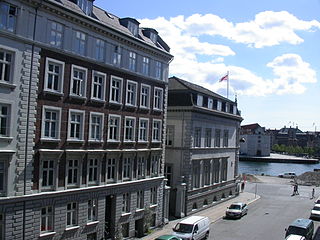
Gammelholm is a predominantly residential neighbourhood in the city centre of Copenhagen, Denmark. It is bounded by the Nyhavn canal, Kongens Nytorv, Holmens Kanal, Niels Juels Gade and the waterfront along Havnegade. For centuries, the area was the site of the Royal Naval Shipyard, known as Bremerholm, but after the naval activities relocated to Nyholm, it came under residential redevelopment in the 1860s and 1870s. The new neighbourhood was planned by Ferdinand Meldahl and has also been referred to as "Meldahl's Nine Streets". Apart from the buildings which face Kongens Nytorv, which include the Royal Danish Theatre and Charlottenborg Palace, the area is characterized by homogeneous Historicist architecture consisting of perimeter blocks with richly decorated house fronts.

The Alexander Nevsky Church is the only Russian Orthodox church in Copenhagen. It was built by the Russian Government between 1881 and 1883, prompted by Princess Dagmar of Denmark's marriage to Alexander Alexandrovich on 9 November 1866 and their later ascent to the Russian throne as Tsar Alexander III of Russia and Tsaritsa Maria Feodorovna. The church is dedicated to the Russian patron saint Alexander Nevsky.

Gothersgade is a major street in the City Centre of Copenhagen, Denmark. It extends from Kongens Nytorv to Sortedam Lake, passing Rosenborg Castle and Gardens, Nørreport Station and Copenhagen Botanic Gardens on the way.

Nørre Voldgade is a street in central Copenhagen, Denmark. It runs north-east from Jarmers Plads for approximately 600 metres to Gothersgade where it turns into Øster Voldgade. The succession of Nørre Voldgade, Øster Voldgade and Vester Voldgade together forms a traffic artery which arches around the Zealand side of the central and oldest part of Copenhagen. Nørreport Station, Denmark's busiest railway station, is located in the street.
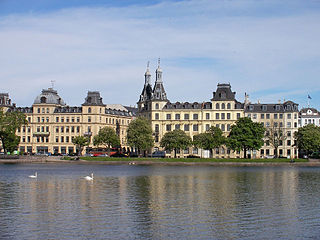
Søtorvet is an elegant late 19th century residential development facing The Lakes in Copenhagen, Denmark. It flanks the end of Frederiksborggade, where it turns into the Queen Louise Bridge, at the intersection with Øster and Nørre Søgade.

The Prince's Mansion is a palatial Rococo-style mansion located at Frederiksholms Kanal in central Copenhagen, Denmark. It used to serve as the official residence of the Crown Prince of Denmark but now houses the National Museum of Denmark.

Store Kongensgade is the longest street in central Copenhagen, Denmark. It extends northeast from Kongens Nytorv to Esplanaden, running parallel to Bredgade, where it breaks left, continuing northwest to Grønningen.
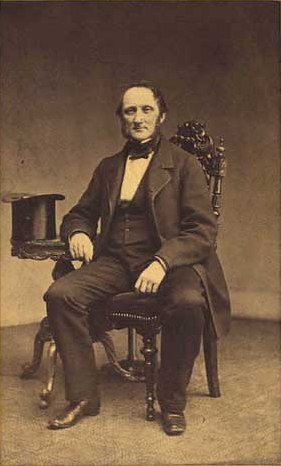
Lauritz Peter Holmblad, often referred to as L. P. Holmblad, was a Danish industrialist and philanthropist. His company, which was simply known as L. P. Holmblad, had activities in dyes, soap, glue and playing cards. Holmblad was also part of the circle around Carl Frederik Tietgen, co-founding several of his companies.
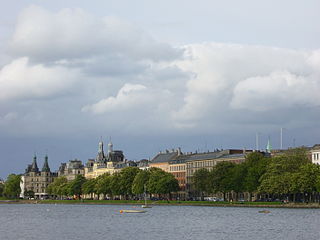
Vester, Nørre and Øster Søgade is a succession of streets along the eastern side of The Lakes in central Copenhagen, Denmark. The streets run from Gammel Kongevej to the south to the beginning of Østerbrogade at Lille Trianglen in the north. Vester Søgade runs from Gammel Kongevej to Gyldenløvesgade, Nørre Søgade runs from Gyldenløvesgade to Dronning Louises Bro, and Øster Søgade from Dronning Louises Bro to Lille Triangel.

Vester Farimagsgade, Nørre Farimagsgade and Øster Farimagsgade is a succession of streets which together connect the south-western Vesterbro to the northern Østerbro along the periphery of the city centre in Copenhagen, Denmark. A continuation of Reventlowsgade, Vester Farimagsgade extends from Vesterbrogade at Vesterport Station and initially runs along the sunken railway tracks on the left before soon reaching H. C. Andersens Boulevard. It then turns into Nørre Farimagsgade and continues behind Ørsted Park to Gothersgade where it becomes Øster Farimagsgade and proceeds along another green space, the Copenhagen Botanical Garden, passes Sølvtorvet and the neighbourhood of terraced houses known as Kartoffelrækkerne before terminating at Lille Triangel where Østerbrogade begins.

Adelgade is a street in central Copenhagen, Denmark. It runs from Gothersgade in the south to Sankt Pauls Plads with St. Paul's Church in the north. The first half of the street is dominated by modern buildings while its last section passes through the Nyboder district.
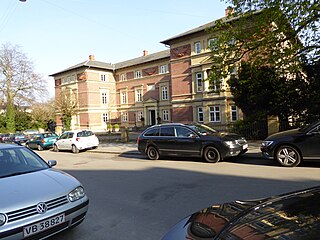
Frederiksberg Åndsvageanstalt is a former mental health treating institution for children located on Rahbeks Allé in the Frederiksberg district of Copenhagen, Denmark. It was founded in 1855 and moved to Ebberød in Birkerød in 1970. Its old main building from 1860 was designed by Ferdinand Meldahl and is listed. It now houses the clothing brand By Malene Birger. Another building has been converted into a daycare. The buildings are located adjacent to the former Carlsberg brewery site, which is under redevelopment into a new, dense neighborhood.

Åbenrå is a street in the Old Town of Copenhagen, Denmark. It runs from Landemærket in the southeast to Rosenborggade in the northwest, linking Vognmagergade with Tornebuskgade. The last part of the street passes the rear side of the grounds of the Reformed Church in Gothersgade. The former rectory associated with the church is located at No. 32-36. It is now houses the Danish Association of Architects.

Christian IX's Gade is a street in central Copenhagen, Denmark. It runs from Gammel Mønt in the south to Gothersgade in the north.

Tegne- og Kunstindustriskolen for Kvinder was a private Danish educational establishment in Copenhagen. From 1875, it aimed to provide better facilities for women to develop competence in visual arts and handicrafts at a time when they were unable to enter the Royal Danish Academy of Fine Arts. The school continued to operate until 1967 when it was merged with the Kunsthåndværkerskolen to form Skole for Brugskunst, later known as Danmarks Designskole.

Bredgade 63–65 are two identical Renaissance Revival style properties situated on Bredgade, adjacent to the small garden complex in front of Østre Landsret, in the Frederiksstaden of central Copenhagen. Denmark. Both buildings were individually listed in the Danish registry of protected buildings and places in 1988. The Mexican Embassy is based at No. 65.


